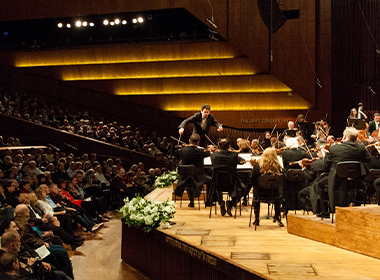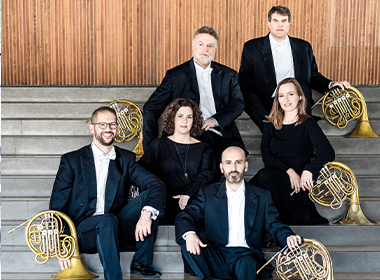Carl Reinecke: Flute Concerto
It is strange to think that Reinecke’s Flute Concerto, considered the most important flute concerto of the Romantic period, was actually written towards the end of the first decade of the 20th century. A further glimpse into Reinecke’s biography reveals that he was a pupil of Schumann, Mendelssohn and Liszt and a close friend of Schumann, so it is hardly surprising that he was their follower. Many consider this piece the flute concerto that Brahms ‘never wrote’.
Alongside a virtuoso and brilliant flute part, which does not fall from any great solo violin concerto of the 19th century, Reinecke also writes many dialogues for the soloist with various instruments – including the brass – creating a colorful and intriguing rainbow of sounds. If we return for a moment to the retrospective aspect, the first movement is inspired by Brahms; the second movement is pensive, mainly in the duet of the solo flute and cello, which allude to operatic arias of Bellini and Donizetti. The third, dazzling movement is powerful and vigorous in true Mendelssohn tradition.
This is our opportunity to hear the brilliant solo playing of IPO Principal Flute Guy Eshed, who has appeared as soloist under Daniel Barenboim, Pierre Boulez and Trevor Pinnock, among others.
Bronislaw Kaper: Confetti
Confetti is an entertaining musical number from the soundtrack of the romantic comedy, Forever, Darling (1956), directed by Alexander Hall, starring Lucille Ball, Desi Arnaz and James Mason. The music was written by Bronislaw Kaper, a Warsaw born composer, who held a prominent place in the American film industry, wrote scores of film music and won an Oscar for the song Hey Lili from the film Lili, starring Leslie Caron. Several of his works became standards, performed by Oscar Peterson, John Coltrane and other jazz giants. Confetti is a short and lively orchestral gem, which has gained renewed popularity and is being performed by numerous orchestras in the USA and England.
Beethoven: Leonore Overture no. 3
Historically speaking, we owe gratitude to Gustav Mahler, who, as Director of the Vienna Opera House, regularly used Leonore Overture no. 3 as an intermediary piece in every performance of Fidelio, Beethoven’s only opera. Other contemporaries of Mahler adopted this idea and it passed from one generation to another, and is still customary nowadays.
Fidelio belongs to the genre of “rescue operas”, in which the protagonist is saved at the last minute from a cruel fate. Therefore, the presence of a solo trumpet fanfare, which heralds the beginning of the rescue, is very significant. Beethoven affords the fanfare a cadenza-like stature, and we know rescue is imminent. The dramatic narrative and musical vigor complement each other at the end of the overture. For various reasons and circumstances, Beethoven wrote four different overtures to Fidelio: three Leonores and one dubbed Fidelio. Leonore no. 3 is undoubtedly the most complete and concert-like of all, and is therefore the most frequently performed.
Beethoven: Symphony no. 6 (“Pastoral”)
A young composer was once asked: “How many symphonies did Beethoven compose?” “Three”, answered the young man, “The Third, Fifth and Ninth”. This anecdote came from a time when the preference was revolutionary works, of a militant nature, among the composer’s odd numbered symphonies, over the more lyrical ones, of a more “classical” nature. This phenomenon, in which people of various generations prefer different works – from a wide repertoire – demonstrates Beethoven’s greatness s a composer. The world appreciates both his even-numbered and odd-numbered symphonies. However, the Pastoral Symphony still merits special clarification. Beethoven himself wrote more annotations for this symphony than any of the others. He was probably concerned that by writing a programmatic work, he was entering a dangerous zone, which could be misunderstood and misinterpreted. We must remember that Beethoven wrote the Fifth and Sixth Symphonies concurrently, so that there are as many revolutionary structural patterns in the Pastoral as in the Fifth. However, as a rule, Beethoven refrained from writing programmatic music, which depicts a scene or event; music that tells a story or conveys an idea outside of the music itself. The Pastoral Symphony is an exception to this rule. Beethoven’s notebook of sketches holds important testaments of the way he chose to write the Pastoral as programmatic music. Examples of this are “Sinfonia caracteristica”, or “Memories from the countryside”; “One should let the listeners discover the situation”; “Pastoral Symphony: not a painting, but more an expression of feelings of a person enjoying nature.” Finally, Beethoven wrote on the score: Pastoral Symphony or memories from the countryside (more the expression of feeling than painting)”.
Following this comment, Beethoven depicted each of the work’s movements. In retrospect, his actions were directed towards one goal: to express in a symphonic work his love for nature and to create a truly rural atmosphere, rather than depicting nature in music. From the first notes of the work, we can already tell that we are in the midst of a narrative, and from now on we will be in the countryside, Beethoven’s most beloved realm, perhaps his preferred ‘escape room’.
Haydn: Sinfonia Concertante in b-flat major for violin, cello, oboe and bassoon
During his visit in London, Haydn wrote his Sinfonia Concertante, his only symphony which he preferred to entitle ”Concertante”.
The Sinfonia Concertante stems from both the symphony and the concerto, and is actually similar in its orchestral medium to the Baroque Concerto Grosso, the origin of the Baroque and Classical concerto. The Concerto Grosso, which was not very popular in the Classical era, features a group of soloists (soli) countered with the entire orchestra (tutti). In this work, Haydn, who is identified with the rise of the Classical symphony and the development of the concerto in its Classical form, creates a hybrid – something between a symphony and a concerto for soloists, but the structure of the work, (three movements in the fast-slow-fast sequence) indicates that it should be considered a concerto, or Concertante, according to Haydn.
At the heart of the work Haydn poses two contrasting ranges of instruments: soprano (oboe and violin) and tenor (bassoon and cello) confronted with the orchestral strings and winds.
Verdi: Requiem
It is fascinating to discover that composers who were far from religion, pronounced atheists, wrote sublime sacred works. Verdi’s Requiem is a fine example of this. Verdi was not a religious man, as attested by his wife Giuseppina Strepponi, herself a devout Catholic: “For some virtuous people, a belief in God is necessary. Others, equally perfect, while observing every precept of the highest moral code, are happier believing in nothing.”
Verdi considered the Requiem a way to honor a person he cherished. In 1863, he came up with the idea of writing a requiem in memory of Rossini: each movement would be written by a different composer, thus affording each an opportunity to depart from a beloved composer. Verdi wrote the last movement (“Libera me”). However, this work was never performed. A musicologist, who sat on the committee that reviewed various works, wrote to Verdi: “Dear Maestro, you wrote the largest, most beautiful and poetic movement that one could imagine. Such a perfect piece has never been, nor ever will be composed.” Verdi later returned to that movement, using it in the entire Requiem, once again in memory of a revered creator, author and poet Alessandro Manzoni.
The premiere was greeted with enthusiasm by the Italian public. However, the German conductor Hans von Bülow, considered a significant interpreter of works by Wagner and Brahms, published a defamatory text on the eve of the premiere in Milan: “… tomorrow you will hear at St. Mark in Milan an opera of monstrous dimensions in ecclesiastical garb …” Brahms was quick to respond, stating that “Von Bülow is making a fool of himself. Only a genius could have written such a work!”
A distinguished conductor such as Zubin Mehta, renowned for his wonderful interpretation of the Requiem, will be able to lead the listeners with ceaseless tension, giving more meaning and importance to this giant work, from the silent beginning, through the trumpet fanfares that envelop the audience, to the solo parts, a-cappella singing and final solo prayer.
The IPO will be joined by no less than three choirs, two of them from Israel – the Gary Bertini Israeli Choir and the Chamber Choir of the Jerusalem Academy of Music – in addition to the Bach Choir from Munich, as well as soloists Krassimira Stoyanova and Mary Elisabeth Williams (soprano), Lyubov Petrova (mezzo-soprano), Gregory Kunde (tenor) and Oleg Tsybulko (bass), all renowned interpreters of the Requiem. Don’t miss this true musical festivity!
program no.1
Zubin Mehta, conductor
Guy Eshed, flutist
Roni Porat, lecturer (intermezzo)
Beethoven: Overture Leonore no. 3
Reinecke: Flute Concerto
Beethoven: Symphony no. 6, op. 68 (“Pastoral”)
program no.2
Zubin Mehta, conductor
Guy Eshed, flutist
Bronislaw Kaper: Confetti
Reinecke: Flute Concerto
Beethoven: Symphony no. 6, op. 68 (“Pastoral”)
program no.3
Zubin Mehta, conductor
Krassimira Stoyanova / Mary Elizabeth Williams, soprano
Olesya Petrova, mezzo-soprano
Gregory Kunde, tenor
Oleg Tsybulko, bass
The Gary Bertini Israeli Choir, directed by Ronen Borshevsky
The Jerusalem Academy Chamber Choir, directed by Stanley Sperber
The Munich Bach Choir, directed by Hansjörg Albrecht
Verdi: Requiem
program no.4
Zubin Mehta, conductor
Guy Eshed, flutist
Christopher Bowman, oboist
Daniel Mazaki, bassoonist
David Radzynski, violinist
Emanuele Silvestri, cellist
Guy Peleg, presenter
Bronislaw Kaper: Confetti
Haydn: sinfonia concertante in b-flat major for violin, cello, oboe and bassoon
Beethoven: The Symphony no. 6 (“Pastoral”)








 Back to top
Back to top





